Power-Development Exercises
This is an excerpt from Complete Conditioning for Lacrosse by Tom Howley.
Explosive power is a major key to success for a lacrosse player. Plyometric training is a way for the athlete to become more explosive and react faster. Band-resisted movements and Olympic variations can also improve power.
The athlete goes through three stages while performing a plyometric movement, and each stage must be executed carefully. The first is the eccentric, or muscle-lengthening, phase, during which energy is generated. The next stage is a slight pause known as the amortization phase. When performing plyometric movements, the athlete should try to shorten this phase as much as possible by minimizing contact time on the ground or between movements. The third phase is the concentric, or muscle-shortening, phase, which is the actual jump or rebound portion of the movement.
Box Jump
The box jump is a great tool for working on double-leg explosiveness. Training with box jumps improves the vertical and broad jumps and helps improve on-field speed by simulating the sudden burst of speed from a stationary position.
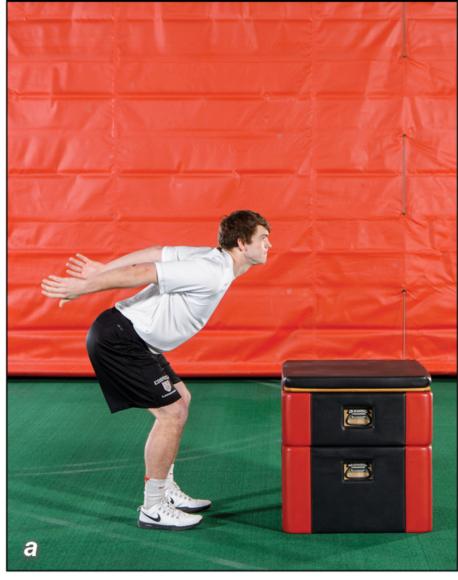
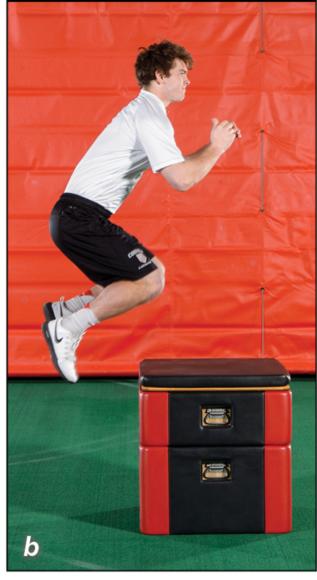
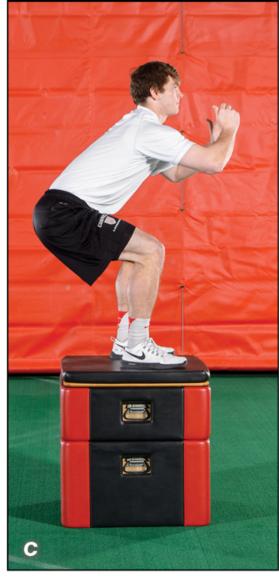
Box jump.
Purpose
This exercise develops lower-body explosiveness.
Equipment
12- to 32-inch (30-80 cm) box
Setup
Stand with the feet approximately shoulder-width apart in front of a box.
Procedure
- Shift the weight back to the heels, flexing at the knee and hip joints slightly. Bring the hands back through the hips (figure 4.52a).
- Keep the back flat and core muscles tightened at all times.
- Drive the hands forward and jump (figure 4.52b), extending the knee and hip joints rapidly.
- Land on box with both feet flat, the knees and hips slightly flexed, and the chest up (figure 4.52c). The objective is to land without a heavy impact.
- Step off the box and repeat.
Single-Leg Power Hop
Single-leg power hops are a great way to train the initial push phase of linear running motion. The athlete can maximize leg power and work on getting full extension of the top leg while maintaining great upper-body running form.
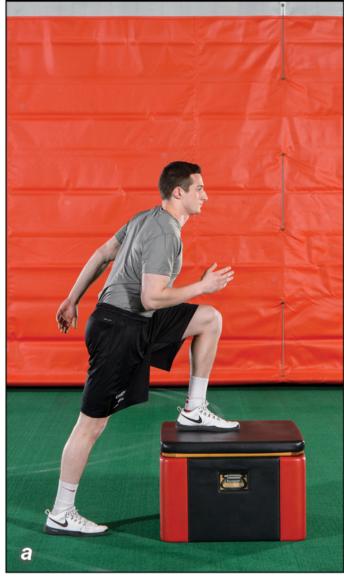
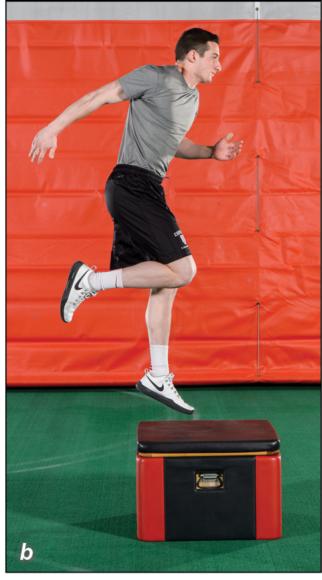
Single-leg power hop.
Purpose
This exercise promotes single-leg explosiveness, balance, and body control.
Equipment
12- to 18-inch (30-45 cm) box
Setup
Stand with one foot on the edge of a box and the opposite foot on the floor (figure 4.53a). Focus the body weight primarily on the front foot. The toes of the front foot should be in front of the knee in the start position and the elbows should be fixed at 90 degrees.
Procedure
- With the chest upright, drive off of the top foot into the air and extend the top knee to full capacity, lifting the foot off of the box if possible (figure 4.53b).
- The elbows should remain fixed at 90-degree angles, with rotation occurring at the shoulder joint and the hands driving down through the hips, much like when running forward.
- Lower to the starting position until balance is achieved and repeat for the prescribed number of reps.
- Repeat with the opposite foot.
Learn more about Complete Conditioning for Lacrosse.
More Excerpts From Complete Conditioning for LacrosseSHOP

Get the latest insights with regular newsletters, plus periodic product information and special insider offers.
JOIN NOW


